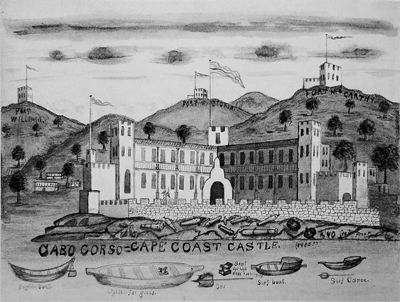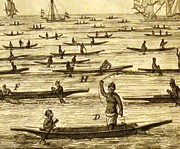
This mid-nineteenth century drawing of various small boats shows the deep history of Ghana's maritime traditions. The vessels in the image appear to be the same form as the canoe in this exhibit thus showing stylistic preservation over time. The image shows Cape Coast Castle in Ghana along with Forts William, Victoria, and McCarthy (Image credit: Drawings of Western Africa, University of Virginia Library, Special Collections, MSS 14357, no 7.).
Maritime Culure
Maritime cultural landscape refers to the human utilization of maritime space, which is done typically through boats. Maritime landscape encompases an entire network of old and new sailing routes, ports and harbors, and the remains of human activity both underwater and on land. Studying maritime culture is just as important as studying terrestrial culture, not just in correlation to landscapes, but as its own topic. Sea routes typically followed three patterns: the first in hugging the coast, the second following the coast line at a distance, the third in the open sea. Sea routes can inform historians of not only where people were traveling too, but what kinds of goods were being traded and transported during different time periods. For the west coast of Africa, especially Ghana, the maritime culture includes fishing 40 miles off the coast and the involvement of the whole community in the boat building process: from tree cutting, construction, painting, and sailing of the boat. With the emergence of the Atlantic Slave Trade during the 16th - 18th centuries, sea routes became important, because valuable property was now being transported at great cost across the waters. (Source credit: Christer Westerdahl, “The Maritime Cultural Landscape,” The International Journal of Nautical Archaeology, 21 (1): 1992.
Previous Next

